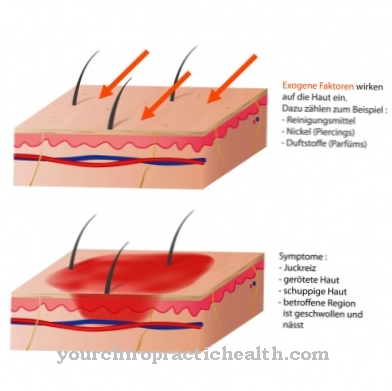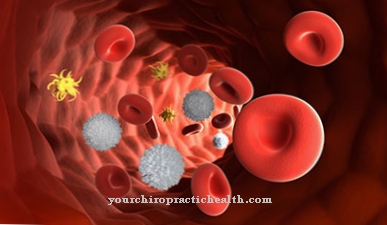The Chloracne is a skin disease caused by contact with chlorinated hydrocarbons and dioxins. It is a symptom of extensive poisoning of the body. The healing process is very tedious.
What is chloracne?

© praisaeng - stock.adobe.com
Chloracne is a subtype of Acne venenata Acne venenata is an exogenous form of acne that is caused by contact with a triggering substance. In addition to chlorine acne, the types of contact acne also include oil acne, tar acne or acne cosmetica. Chloracne is a symptom of poisoning of the body with polychlorinated hydrocarbons and dioxins.
These are skin changes that are typical of acne, but arise from direct skin contact with the contact poison. The skin forms comedones (blackheads), abscesses, lumps and cysts. Cornifications appear on the hair follicle. The term chloracne was first used by the German physician Karl Herxheimer after he examined a worker suffering from severe acne. He found that the sick workers were employed in the chlor-alkali electrolysis.
causes
At that time Karl Herxheimer still thought that chlorine alone was the trigger for chloracne. According to current knowledge, however, polychlorinated dibenzodioxins and dibenzofurans are produced as by-products in the production of chlorine. Over the years, it became clear that chlorinated hydrocarbons such as chloronaphthalenes, pentachlorophenol, chlorophenol and polychlorinated dibenzodioxins or dibenzofurans are the cause of chlorine acne.
The skin change is only a symptom of extensive poisoning. It is caused by direct contact of the poison with the skin, by ingestion or by inhalation of toxic fumes. The body parts that come into contact with the chlorine compounds are particularly affected by acne. This is especially true for the face. Dioxin plays a special role as a trigger for chloracne. Dioxins are created when burning, melting and producing compounds containing chlorine. Even in small amounts, dioxins are extremely toxic and carcinogenic.
They are contained in certain wood preservatives, pesticides or hydraulic oils, among other things. Therefore, chlorine acne often develops on intensive contact with these substances. There are also frequent cases of chloracne after chemical accidents. In 1976, after the chemical accident in Seveso, Italy, 187 children fell ill. It could not be clearly determined why children in particular suffered from chloracne.
Either children are more sensitive than adults or they came into closer contact with the poison via contaminated playgrounds. In the electrical industry, the perchloronaphthalenes used there sometimes cause what is known as Perna disease with chloracne, nervousness, anemia and weight loss.
Symptoms, ailments & signs
Chloracne is characterized by serious skin changes. This results in numerous comedones (blackheads), inflammatory abscesses, thickening of the horny layer and lumps on the affected skin areas. Chloracne is always only a symptom of extensive poisoning with chlorinated hydrocarbons. The overall appearance of the poisoning is more complex.
Often there is also nervousness, psychological problems, weight loss, anemia or liver failure. In very severe cases, the internal organs are also severely affected. Cancer can develop as a result of poisoning. Depending on the degree of intoxication, the course of the disease can be very difficult. Usually a chronic course sets in. The healing process, if it occurs at all, is very tedious. The polychlorinated hydrocarbons are lipophilic and are therefore stored in adipose tissue. Since the toxins are broken down very slowly, the symptoms persist for a very long time.
diagnosis
The diagnosis of chloracne can only be based on the symptoms. When the typical skin changes occur, the doctor will take an intensive medical history. This anamnesis will be about clarifying possible pollution in living and working areas. Under certain circumstances, a pollutant measurement is also useful in order to determine the source of the toxicity.
Complications
Many complications can arise with chloracne during and after the healing process. Depending on the degree of poisoning and the type and duration of the therapies carried out, scars can often remain on the skin due to larger inflamed areas of the skin, cysts and abscesses. Permanent damage to internal organs can lead to chronic impairment and even death.
Among other things, sarcomas can form on skin and connective tissue as well as lung cancer. There is also an increased risk of leukemia. Raised cholesterol levels and an increase in free fats in the blood are signs and consequences of liver damage. A disease of the gastrointestinal tract often manifests itself as diarrhea and vomiting.
It can also cause permanent damage to the central nervous system. Symptoms of this are motor and sensory failures such as numbness of individual limbs, as well as headaches, irritability and insomnia. The sustainable storage of the poison also has an impact on the reproductive organs.
As a result, the woman may have miscarriages and the man may be unable to conceive. The body is generally more susceptible to infections and metabolic irregularities. As long as there is still poison in the body, breastfeeding is not possible, as the toxins accumulate particularly high in the fatty breast milk.
When should you go to the doctor?
After contact with chlorinated hydrogen such as pentachlorophenol, chlorophenol or chloronaphthin, a doctor must be consulted immediately. Even the mere suspicion of poisoning, for example due to possible pollution in living and working areas, requires immediate clarification by a doctor.
Inflammatory abscesses, lumps, blackheads and other skin changes are clear signs of chloracne and require immediate treatment. The doctor can determine the disease based on a comprehensive medical history and visual diagnosis and initiate appropriate treatment. If left untreated, however, the poisoning can be severe. As a result of chloracne, physical and mental complaints can occur, which make therapy even more difficult.
It is therefore advisable to speak to a specialist at the first signs of illness. Ideally, possible pollution should be clarified early on by an expert and, if necessary, remedied. By avoiding the poison that occurs in wood preservatives, pesticides and technical oils, the outbreak of chloracne can be reliably prevented.
Doctors & therapists in your area
Treatment & Therapy
Therapy for chloracne is very tedious and, if at all, usually leads to healing after a very long time. Treatment is carried out, for example, by opening and draining cysts. At the same time, hormone-containing and anti-inflammatory drugs are administered. Medicines containing hormones are available in the form of tablets. Anti-inflammatory drugs can be applied with the help of creams and ointments or in the form of tablets.
Vitamin A acid preparations (retinoids) are also given. These are first generation non-aromatic retinoids. Their main representatives, tretinoin and isotretinoin, are used both locally (topically) and systemically. However, the effectiveness of retinoids in combating chloracne has not been clearly established. The scarring can be reduced with cold therapy.
Excess scar tissue is removed by briefly applying ice. Skin peelings and skin ablations (dermabrasion) are also carried out. Nevertheless, with a chronic and persistent course, scars are often left behind. With dermabrasion, the top layer of skin is removed with a special grinding instrument.
Wound treatment is carried out by applying a drug that combines with the wound secretion. The scab loosens after about eight to ten days. Complete healing takes a very long time. However, there is not always a cure because the toxins remain in the fatty tissue for a very long time and are only broken down very slowly.
Outlook & forecast
The prognosis for chloracne is unfavorable and depends on the severity of the disease and the start of treatment. Most patients cannot cure chloracne with the medical options available up to now. Treatment is therefore aimed at relieving the symptoms that are present. In addition, attempts are made to prevent the damage from progressing and spreading.
In the case of severe poisoning, the course of the disease is fatal within a short time. Most patients have lifelong impairments due to severe skin changes or functional disorders of individual bodily systems. The organ tissue destroyed by the poisoning is irreparable and cannot be regenerated. Depending on the intensity of the disease and the patient's state of health, there is the possibility of an organ transplant.
Treatment of the disease often takes place for life. Mostly it takes a chronic course. Many symptoms of chloracne cannot be treated medically despite great efforts. There is a chance of a cure in only a few patients and mild chloracne. This is tedious and usually lasts for decades. The reason for this is that, due to their natural half-life, the toxins are only broken down very slowly and only then can be removed from the organism. Secondary diseases such as organ failure or cancer are more likely.
prevention
Since chlorine acne is triggered by poisoning with polychlorinated hydrocarbons, it can only be prevented by avoiding contact with these poisons. If necessary, measurements of pollutants in living and working areas provide information about the presence of polychlorinated hydrocarbons from wood preservatives, pesticides and technical oils.
Aftercare
After treatment with anti-inflammatory drugs, chlorine acne can be treated with home remedies such as ice packs and aloe vera. However, the therapy can take several years. The transition from treatment to aftercare is fluid. With medicinal ointments, the skin disease can usually only be alleviated, but not completely cured.
In this context, it is important that the damage does not worsen and spread. The chronic course can only be stopped completely in a few cases. Therefore, patients should be patient and careful with their activities. Contact with chlorinated water must be avoided at all costs.
Working in the chemical or electrical industry can also have a negative effect on the clinical picture. It may sometimes be necessary to change jobs if protective suits and other protective measures do not have the desired effect. An optimistic attitude helps those affected to accept the situation.
Skin care routine should also be adjusted to avoid itching and other problems. It may be useful to seek advice from a naturopath who relies on natural ingredients. Together with a balanced diet, this prevents internal organ diseases. Psychotherapy helps against possible depression and complexes.
You can do that yourself
Chloracne is particularly widespread among workers in the electrical and chemical industries. It is a chronic disease and the chances of recovery are slim. Contact with water containing chlorine also causes symptoms. Since even inhaling the vapors has noticeable consequences, applying protective ointments such as Vaseline does not help either.
Inflammatory processes can be alleviated using home remedies. Anti-inflammatory ointments, ice packs, aloe vera and low-fat quark are helpful. The latter is often used for external inflammation and is very effective. Peelings are also recommended.
Since chloracne is predominantly incurable, a positive attitude towards life is a helpful tool to deal with it. Self-acceptance with all its inadequacies also strengthens the attitude to life. Skin care must be adapted and - very importantly - any contact with chlorine must be avoided. If necessary, those affected should change jobs if protective suits prove to be insufficient.
Scratching doesn't help and leaves scars. A healthy and balanced diet helps prevent diseases of the internal organs. If necessary, a naturopath can be consulted who can use natural active ingredients in a targeted manner. Depression can occur but is detrimental to relief. If they do, they can be resolved with the help of family, friends, and a psychotherapist.













.jpg)

.jpg)
.jpg)











.jpg)